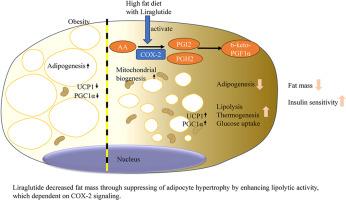Activation of cyclooxygenase-2 signaling mediates liraglutide-induced adipose lipolytic activity
IF 4.7
3区 医学
Q1 PHARMACOLOGY & PHARMACY
引用次数: 0
Abstract
Pharmacological benefits of glucagon like peptide-1 receptor agonist (GLP-1RA) were mainly contributed to body weight reduction. This study aims to identify the novel mechanisms by which liraglutide improves adipose tissue homeostasis through cyclooxygenase (COX)-2 signaling. Liraglutide's impact on metabolic parameters in vivo was assessed in high-fat diet (HFD)-induced obese mice received liraglutide (1 mg/kg/day) treatment. In vitro experiments were conducted with differentiated adipocytes, and non-targeted metabolomics sequenced to identify key metabolites and COX-2 involvement during cold exposure. Liraglutide improved metabolic insulin resistance, accompanied with reduction of body weight and individual fat weight. Liraglutide suppressed adipocyte hypertrophy whereas induced lipolytic activity, including upregulation of browning-related markers PGC1α, UCP1, and ATGL in obese adipose tissues and differentiated 3T3-L1 adipocytes. Metabolomics analysis revealed elevated activation of COX-2 signaling, including increasing levels of COX-2 signaling and prostaglandin levels in subcutaneous adipose tissue from liraglutide-treated obese mice. COX-2 inhibition abolished liraglutide's effects on adipogenesis and lipolysis, and impaired adaptive thermogenesis in response to cold. In conclusions, liraglutide suppressed adipocyte hypertrophy dependent on upregulation of COX-2 activity. Targeting COX-2 pathway in adipose tissue was one of clinical concerns when obese patient treated with GLP-1RA.

环氧化酶-2信号的激活介导利拉鲁肽诱导的脂肪解脂活性
胰高血糖素样肽-1受体激动剂(GLP-1RA)的药理作用主要是减轻体重。本研究旨在确定利拉鲁肽通过环氧化酶(COX)-2信号通路改善脂肪组织稳态的新机制。利拉鲁肽对体内代谢参数的影响在高脂饮食(HFD)诱导的肥胖小鼠中进行了评估,利拉鲁肽(1mg /kg/天)治疗。利用分化的脂肪细胞进行体外实验,并进行非靶向代谢组学测序,以确定冷暴露过程中关键代谢物和COX-2的参与情况。利拉鲁肽改善代谢性胰岛素抵抗,并伴有体重和个体脂肪重量的减少。利拉鲁肽抑制脂肪细胞肥大,同时诱导脂肪分解活性,包括肥胖脂肪组织中褐化相关标记物PGC1α、UCP1和ATGL的上调以及分化的3T3-L1脂肪细胞。代谢组学分析显示,利拉鲁肽治疗的肥胖小鼠皮下脂肪组织中COX-2信号传导和前列腺素水平升高,COX-2信号传导水平升高。COX-2抑制消除了利拉鲁肽对脂肪生成和脂肪分解的影响,并削弱了对寒冷的适应性产热反应。总之,利拉鲁肽抑制脂肪细胞肥大依赖于COX-2活性的上调。GLP-1RA治疗肥胖患者时,针对脂肪组织中的COX-2通路是临床关注的问题之一。
本文章由计算机程序翻译,如有差异,请以英文原文为准。
求助全文
约1分钟内获得全文
求助全文
来源期刊
CiteScore
9.00
自引率
0.00%
发文量
572
审稿时长
34 days
期刊介绍:
The European Journal of Pharmacology publishes research papers covering all aspects of experimental pharmacology with focus on the mechanism of action of structurally identified compounds affecting biological systems.
The scope includes:
Behavioural pharmacology
Neuropharmacology and analgesia
Cardiovascular pharmacology
Pulmonary, gastrointestinal and urogenital pharmacology
Endocrine pharmacology
Immunopharmacology and inflammation
Molecular and cellular pharmacology
Regenerative pharmacology
Biologicals and biotherapeutics
Translational pharmacology
Nutriceutical pharmacology.

 求助内容:
求助内容: 应助结果提醒方式:
应助结果提醒方式:


